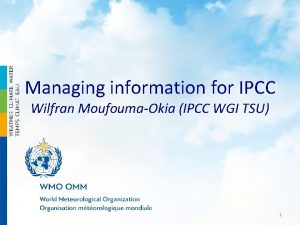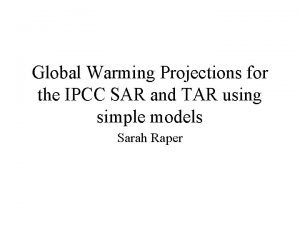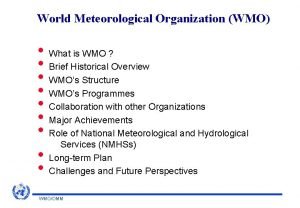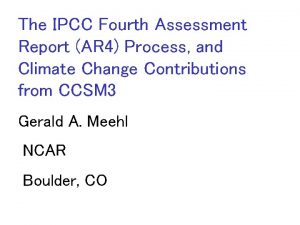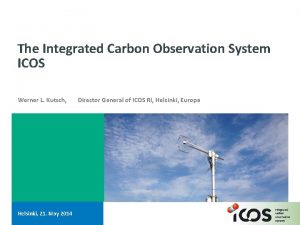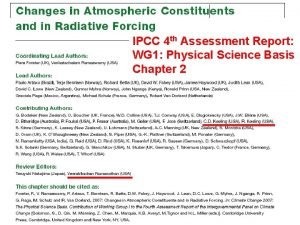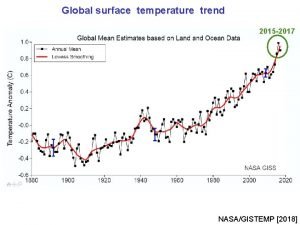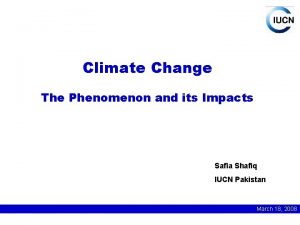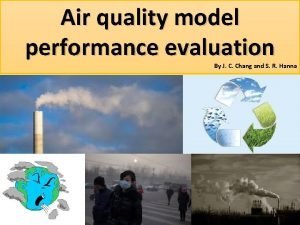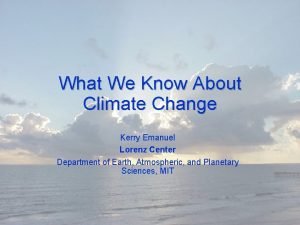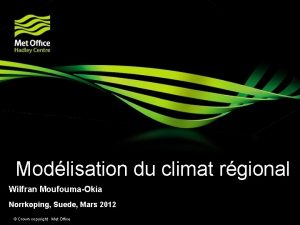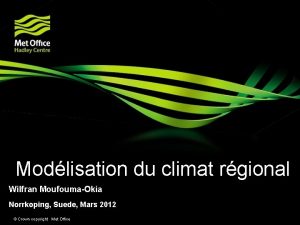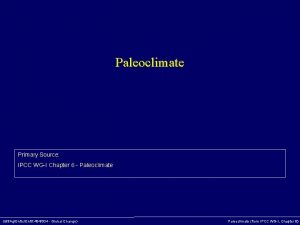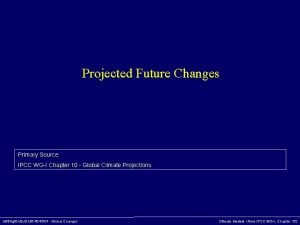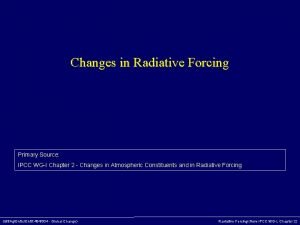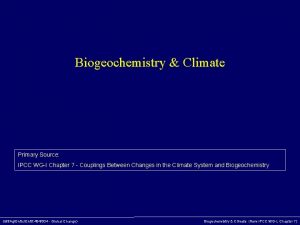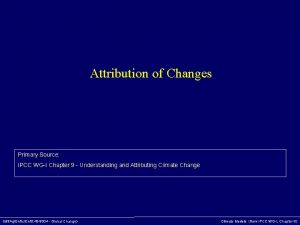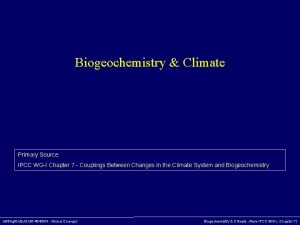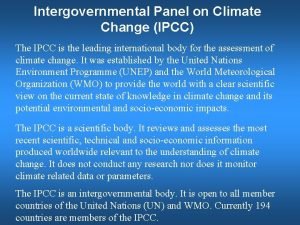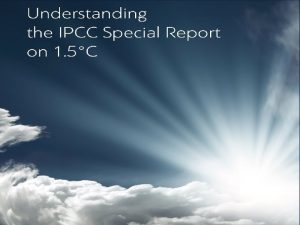Managing information for IPCC Wilfran MoufoumaOkia IPCC WGI
















- Slides: 16

Managing information for IPCC Wilfran Moufouma-Okia (IPCC WGI TSU) 1

IPCC role and structure “… to assess on a comprehensive, objective, open and transparent basis the scientific, technical and socioeconomic information relevant to understanding the scientific basis of risk of human-induced climate change, its potential impacts and options for adaptation and mitigation. ” Composition: 3 Working Groups + Task force: • WGI: Physical science basis • WGII: Impacts, vulnerability and adaptation • WGIII: mitigation of climate change Policy relevant but not policy prescriptive

IPCC – jointly established by WMO and UNEP FAR UNFCC C SAR TAR Kyoto Adaptat Protocoion l AR 4 2 °C limit AR 5 SR 1. 5 SRs MR AR 6 UNFCC C Paris Global Agreement Stockta ke Nobel Peace Prize 1988 1970 s 1980 s 2007 1995 1990 2001 20182019 2013/2014 2023 2016 -2022

WGI working principles “Reliable detection and attribution of changes in climate, and their effects, is fundamental to our understanding of the scientific basis of climate change” • • Rigor, scientific accuracy, and comprehensiveness Traceability of findings Transparency of findings Use of peer-reviewed literature Consistent treatment of uncertainties Reconciling assessment of multiple data product Assessing performance of multi-model climate simulations Combining multi model climate projections

Certainty of key findings

AR 5 Working Group I Outline 1: Introduction 2: Observations: Atmosphere and Surface 3: Observations: Ocean 4: Observations: Cryosphere 5: Information from Paleoclimate Archives 6: Carbon and Other Biogeochemical Cycles 7: Clouds and Aerosols 8: Anthropogenic and Natural Radiative Forcing 9: Evaluation of Climate Models 10: Detection and Attribution of Climate Change: from Global to Regional 11: Near-term Climate Change: Projections and Predictability 12: Long-term Climate Change: Projections, Commitments and Irreversibility 13: Sea Level Change 14: Climate Phenomena and their Relevance for Future Regional Climate Change Observations Processes Models Synthesis

Observational evidence of climate changes

Systematic quantification of model performance

Assessing future climate change responses

Detection and attribution of climate change

IPCC Data Distribution Centre (DDC) v Hosting the reference archives for climate data outputs underlying the IPCC assessments, though archival of observational datasets is beyond DDC capacity v. Designed to facilitate timely distribution of consistent scenarios of changes in climate and related environmental and socio-economic factors for use in climate impact and adaptation assessment. v Ensures that unambiguous attribution is given to a) authors and distributors of the resource; b) data curation; and c) institutions responsible for reviewing or ensuring the quality of the resource (e. g. , the IPCC). v Recently designed activities to improve traceability and curation of source datasets

New dimensions and challenges to consider: WGI Outline Summary for Policy Makers Technical Summary Link to WGIII Chapter 1: Framing, context, methods Chapter 2: Changing state of the climate system Chapter 3: Human influence on the climate system Chapter 4: Future global climate: scenario-based projections and near-term information Chapter 5: Global carbon and other biogeochemical cycles and feedbacks Chapter 6: Short-lived climate forcers Chapter 7: The Earth’s energy budget, climate feedbacks, and climate sensitivity Chapter 8: Water cycle changes Chapter 9: Ocean, cryosphere, and sea level change Chapter 10: Linking global to regional climate change Chapter 11: Weather and climate extreme events in a changing climate Chapter 12: Climate change information for regional impact and for risk assessment Annexes incl. options for a Regional Atlas and Technical Annexes Glossary Index

AR 6 model data: Combining myriad of sources CMIP 6 based on WCRP Grand Challenges: (1) Clouds, circulation and climate sensitivity, (2) Changes in cryosphere, (3) Climate extremes, (4) Regional climate information, (5) Regional sea-level rise, and (6) Water availability, plus an additional theme on “Biogeochemical forcings and feedbacks” • • • Net. CDF standards Distribution via ESGF Most widely used: GCM/ESM runs

The CORDEX vision is to advance and coordinate the science and application of regional climate downscaling through global partnerships. Original experimental protocol (modified from Giorgi et al. , 2009): • 14 standard domains (each with contact points) • 0. 44 degrees or ~50 km (but also few 0. 11 degrees, i. e. ~12 km) • ERA and CMIP 5 -forced simulations • Historic 1950 -2005 • RCP 4. 5 and RCP 8. 5 2006 -2100 • Core set of variables has to be archived – Net. CDF CORDEX is largely an unfunded activity – of which expectations are very high www. cordex. org International Project Office for CORDEX(IPOC) hosted at SMHI in Sweden

Lessons from IPCC WGI practices v Need to ensure transparent and traceable account of IPCC key findings including data sources used to provide multiple lines of evidences and figures v Need to ensure curation of data sources v Archiving observational datasets and model data outputs is beyond the current capacity of the IPCC Data Distribution Centre – WMO programmes (GCOS, WCRP, …etc) could play a crucial role to support v IPCC WGI Technical Support Unit can help compile recipes for producing figures of Working Group I reports.

Thank you Merci 16
